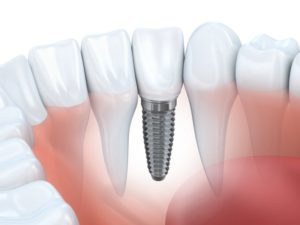 Dental implants can be an excellent solution for missing teeth – they provide great chewing power, they’re not prone to slipping like traditional dentures, and they can last a long time when well-cared for. However, if the jawbone isn’t in good health, there could be complications. Here’s are the reasons why bone loss can create a problem when getting dental implants – as well as the ways it can be solved!
Dental implants can be an excellent solution for missing teeth – they provide great chewing power, they’re not prone to slipping like traditional dentures, and they can last a long time when well-cared for. However, if the jawbone isn’t in good health, there could be complications. Here’s are the reasons why bone loss can create a problem when getting dental implants – as well as the ways it can be solved!
Why Does Bone Loss Occur?
Bone loss is usually the result of missing teeth. Normally, the stimulation received from the force of chewing helps keep the jawbone strong. When a tooth is missing, that stimulation is gone, and the bone begins to deteriorate. This can lead to difficulties while eating and talking as well as the appearance of facial collapse.
How Can Bone Loss Affect Implants?
Implants are surgically attached to the jawbone in order to provide support for prosthetic teeth. Under normal circumstances, the implant is fused with the bone via a process called osseointegration; not only does this hold it in place, but it also allows it to provide stimulation from chewing, meaning it can prevent bone loss from progressing further.
If the jawbone has already deteriorated too much, however, osseointegration won’t take place. An implant that doesn’t integrate with the jaw is considered to have failed and must be removed. For this reason, implants often are not used for patients who have already suffered too much bone loss.
Can Bone Loss Be Repaired?
The good news is that in some cases, implants might still be possible if the jawbone is properly prepared. Some methods for doing so include:
- Bone Grafting: This process involves taking bone from another area of your body, such as your hip, and placing it on the jawbone where the implant will be placed. Artificial materials can be used as well. Note that bone grafts may affect implant recovery time.
- Ridge Expansion: This is a different kind of bone graft that’s used to widen the jaw in order to make room for implants.
- Sinus Lift: This procedure adds bone to the maxillary sinus (located above the back teeth on either side of the nose), which helps prepare the back part of the upper jaw for implant placement.
- Distraction Osteogenesis: This procedure involves separating a piece of bone from the rest of the jaw and reattaching it with a titanium device that is gradually unscrewed to make the jawbone taller. This allows new bone to grow to fill the gap.
Not all patients may be suitable for each of these procedures. Your dentist in Inwood can examine your jawbone and the current state of your oral health before making a recommendation for the best course of treatment. Make sure you understand your options and always ask questions so that you fully understand what’s being suggested; it’s important to make the choice that’s best for your smile!
About the Author
Dr. Mark E. Lawton received his Doctor of Dental Surgery at the University of Texas Health Science Center at San Antonio Dental School. He offers dental implants for patients with missing teeth as well as other restorative dentistry options such as dental crowns and bridges. To schedule an appointment at his practice, visit his website or call (281) 447-2186.